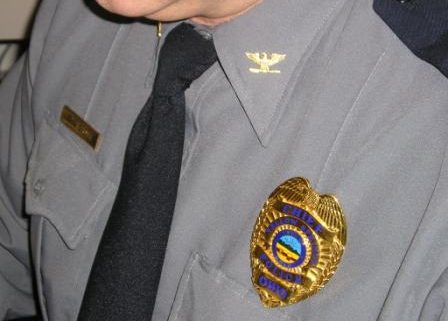Keep Your Shirt On
Uniform shirts worn by police officers are not your normal off-the-rack clothing. Shirts like the one pictured above are made from a polyester, cotton, or wool blend. Sometimes, the material is treated with fire retardant. Some shirts have zippered fronts to prevent lost buttons during a scuffle with combative bad guys.
Department policy typically dictates when officers may switch from short sleeve shirts to the wintertime long sleeve shirts. The same is true in reverse and makes for some uncomfortable days if there’s an early, hot spring.
Ties are usually worn with long sleeve shirts, but not necessarily so with short sleeve uniform shirts. Military creases are permanently sewn into the material. The same is true with the two badge tabs over the left pocket. Badge tabs are two button hole-like openings, one over the other, and are used to accept the large pin on the back of the officer’s badge. This prevents poking multiple holes in the fabric when pinning on a badge day after day.
Name tags are worn over the right pocket and are held in place by two pins backed by push-type clasps similar to the backs of pierced ear rings. This works well until an officer gets into a scuffle with a suspect. In the old days, before officers wore protective vests, a sharp blow to the chest almost always resulted in the pins being pushed through the clasps and into the officer’s skin. Another fault with the name tag clasps is that they tend to become loose and fall off. A quick fix for the issue is to use a pencil eraser as a backing.
Officers wear insignias on their collars to indicate their rank. The gold eagle on the collar pictured above denotes a chief of police. Some chiefs, however, prefer to use three or four gold general’s stars to indicate their status as the top ranking officer of their department. This is especially true in large departments when there are ranks between a chief and a major. A good example would be a department with a deputy chief. This high-ranking official, the second in command, would probably wear one less gold star than the chief of police.
Other insignias are:
Golden oak leaf – Major
Two parallel bars (nicknamed railroad tracks) – Captain
One bar – Lieutenant
Three stripes – Sergeant
Two stripes – Corporal
One stripe – Private, or line officer (not all departments utilize the one stripe)
No insignia – Rookie status, or line officer
Long horizontal stripes—aka hash marks—on the shirt sleeves indicate an officer’s length of service in five-year increments. An officer with three stripes on his sleeve has been a sworn police officer for at least fifteen years. Neckties clip on to prevent suspects from using them to choke an arresting officer during a struggle. Patches on the sleeve are sometimes designed by a chief or sheriff and normally indicate the city, town, or state where the officer has jurisdiction. Badges also display the name of the jurisdiction as well as the rank, if any, of the officer. The center of the badge is normally adorned with the state’s seal. Ranking (supervisory) officers normally wear gold badges while rank and file (line) officers wear silver badges. Detectives often wear gold badges.




